Business Proposal: Biodegradable Straw Management for Sustainability
VerifiedAdded on 2022/09/08
|14
|4288
|16
Project
AI Summary
This business proposal outlines a plan for a biodegradable straw business in New Zealand, addressing the pressing issue of plastic pollution. The proposal includes an executive summary highlighting the product's sustainable nature and its focus on profitability, sustainability certification, and plastic reduction. The analysis incorporates a PESTLE framework to assess the business environment, competitor analysis focusing on 'Profile International,' potential challenges like low market share and customer trust, and strategic decisions such as market expansion and cost leadership. The proposal also considers ethical and cultural issues, including the integration of Maori employees, and proposes a team-based organizational structure. It leverages 3D printing and cloud computing for technological advancements and utilizes various marketing channels to communicate its value proposition. Ultimately, the proposal aims to contribute to a more sustainable New Zealand by providing an eco-friendly alternative to plastic straws and supporting the Maori community.
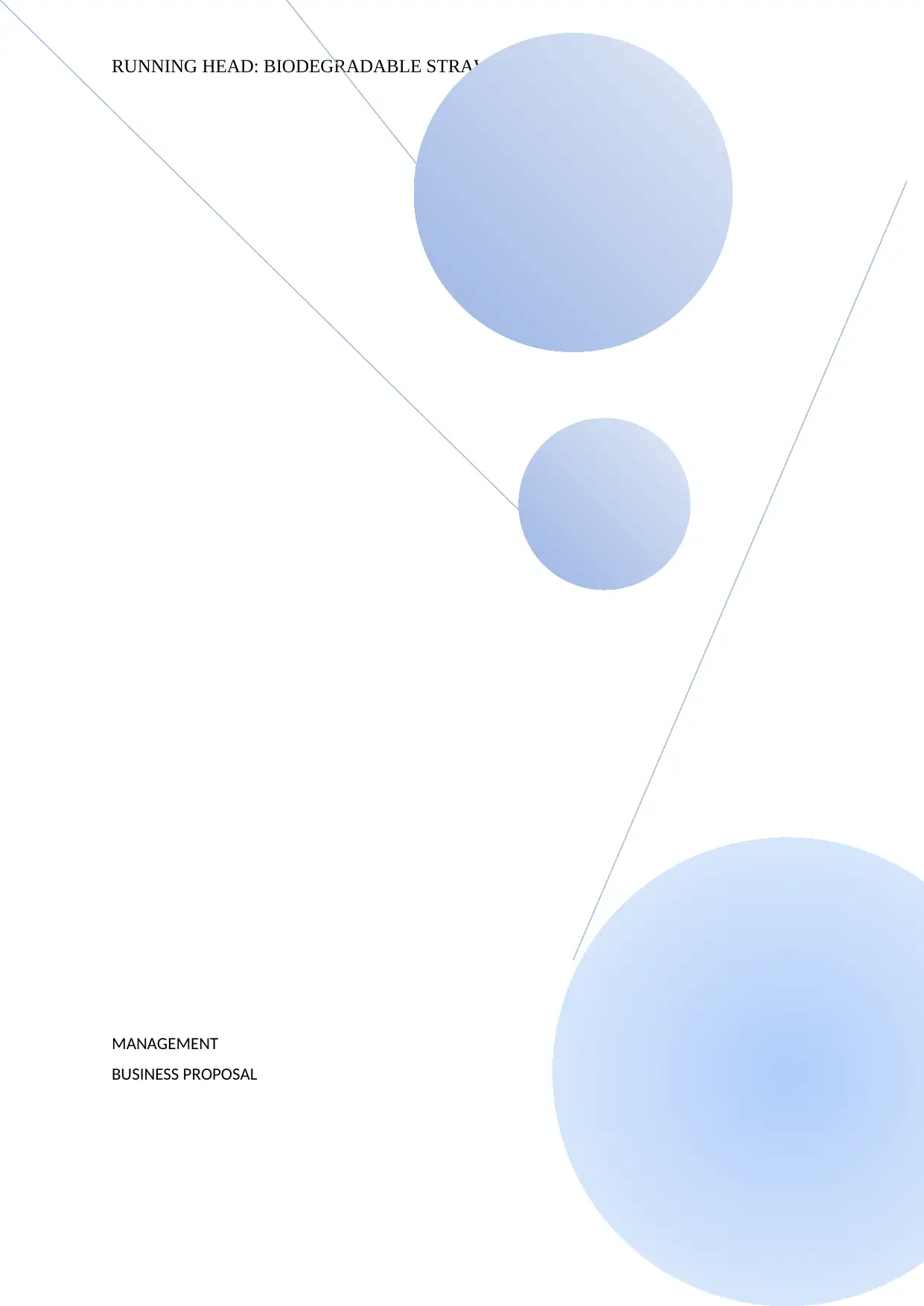
RUNNING HEAD: BIODEGRADABLE STRAW
MANAGEMENT
BUSINESS PROPOSAL
MANAGEMENT
BUSINESS PROPOSAL
Paraphrase This Document
Need a fresh take? Get an instant paraphrase of this document with our AI Paraphraser
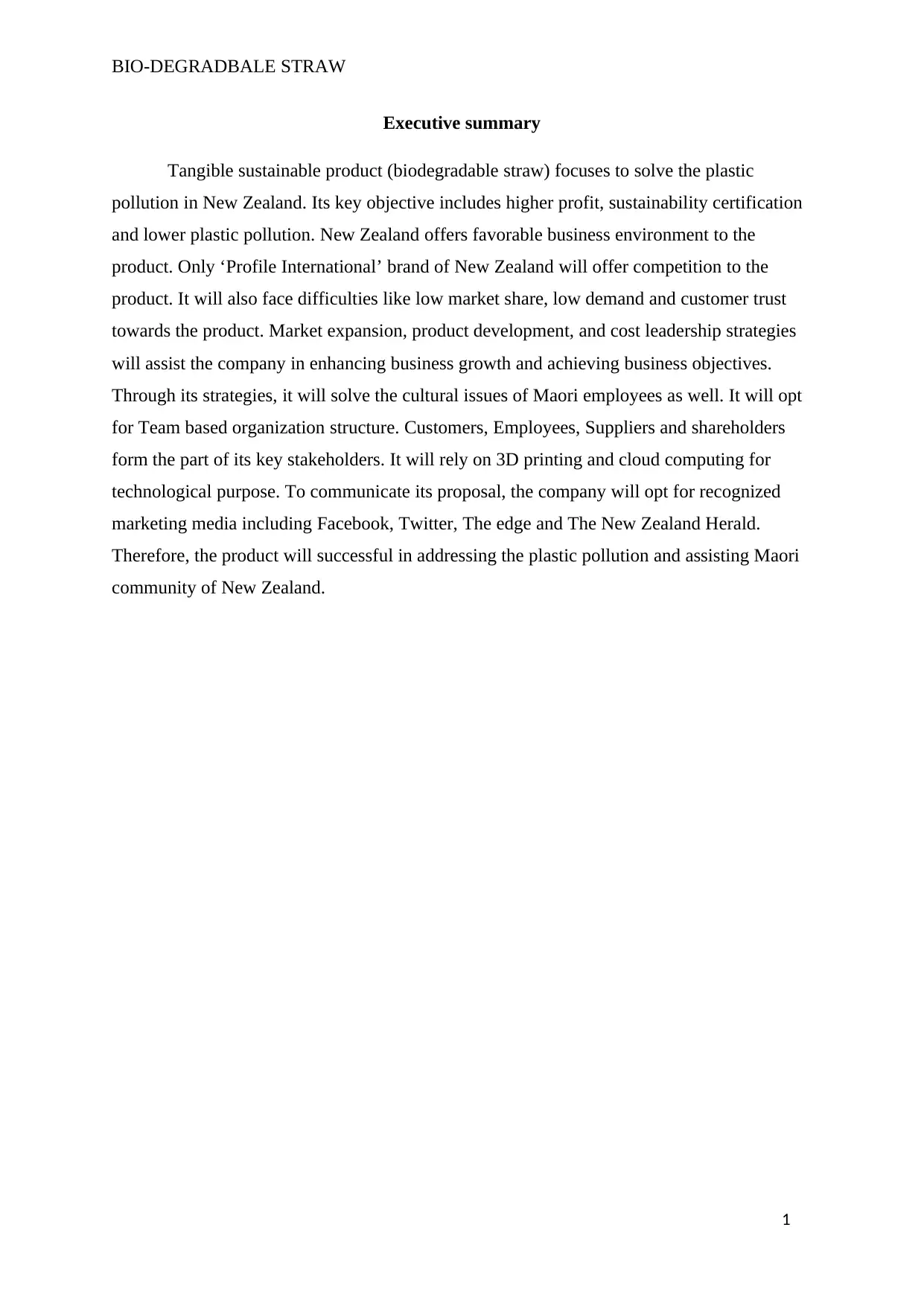
BIO-DEGRADBALE STRAW
Executive summary
Tangible sustainable product (biodegradable straw) focuses to solve the plastic
pollution in New Zealand. Its key objective includes higher profit, sustainability certification
and lower plastic pollution. New Zealand offers favorable business environment to the
product. Only ‘Profile International’ brand of New Zealand will offer competition to the
product. It will also face difficulties like low market share, low demand and customer trust
towards the product. Market expansion, product development, and cost leadership strategies
will assist the company in enhancing business growth and achieving business objectives.
Through its strategies, it will solve the cultural issues of Maori employees as well. It will opt
for Team based organization structure. Customers, Employees, Suppliers and shareholders
form the part of its key stakeholders. It will rely on 3D printing and cloud computing for
technological purpose. To communicate its proposal, the company will opt for recognized
marketing media including Facebook, Twitter, The edge and The New Zealand Herald.
Therefore, the product will successful in addressing the plastic pollution and assisting Maori
community of New Zealand.
1
Executive summary
Tangible sustainable product (biodegradable straw) focuses to solve the plastic
pollution in New Zealand. Its key objective includes higher profit, sustainability certification
and lower plastic pollution. New Zealand offers favorable business environment to the
product. Only ‘Profile International’ brand of New Zealand will offer competition to the
product. It will also face difficulties like low market share, low demand and customer trust
towards the product. Market expansion, product development, and cost leadership strategies
will assist the company in enhancing business growth and achieving business objectives.
Through its strategies, it will solve the cultural issues of Maori employees as well. It will opt
for Team based organization structure. Customers, Employees, Suppliers and shareholders
form the part of its key stakeholders. It will rely on 3D printing and cloud computing for
technological purpose. To communicate its proposal, the company will opt for recognized
marketing media including Facebook, Twitter, The edge and The New Zealand Herald.
Therefore, the product will successful in addressing the plastic pollution and assisting Maori
community of New Zealand.
1
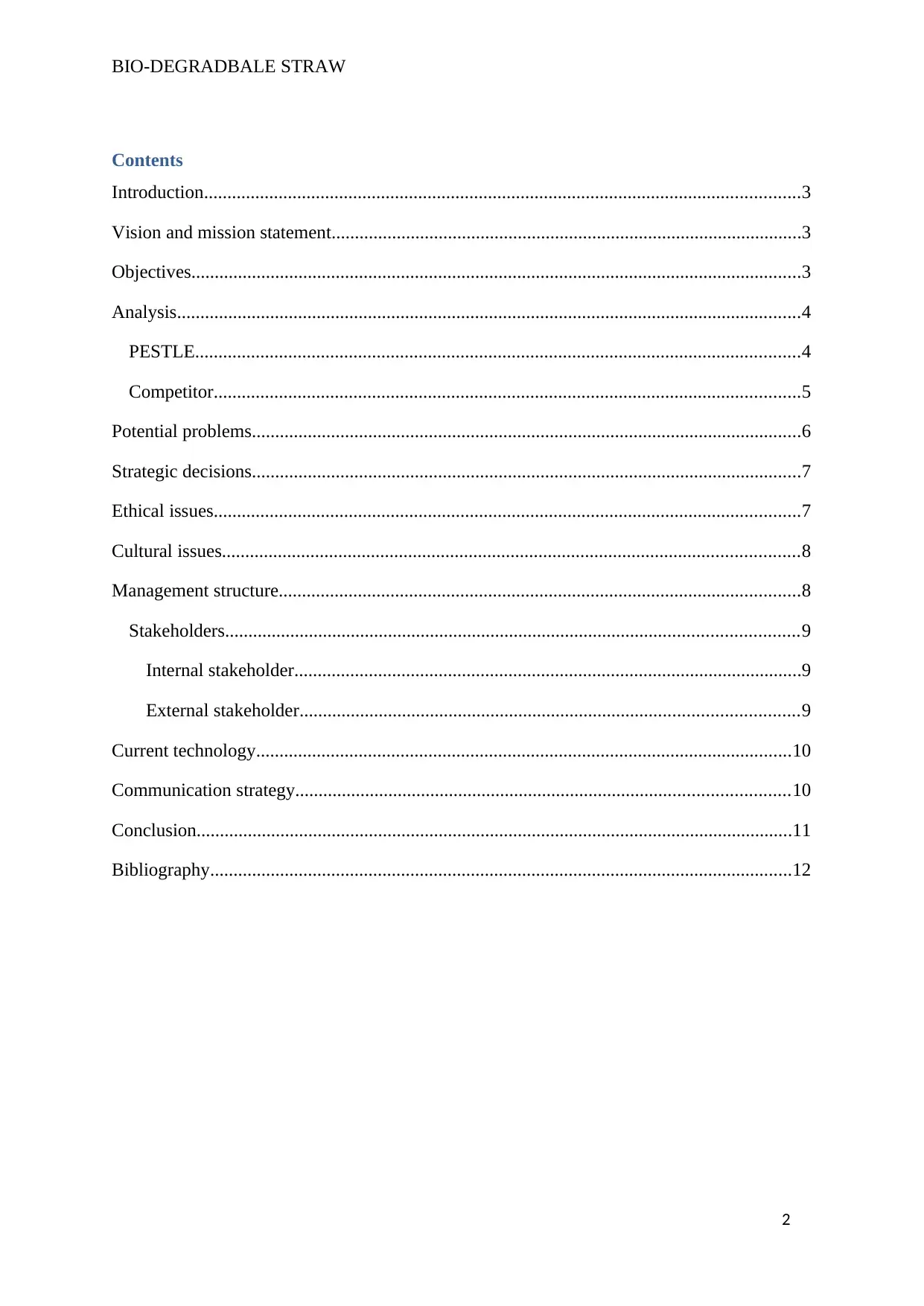
BIO-DEGRADBALE STRAW
Contents
Introduction................................................................................................................................3
Vision and mission statement.....................................................................................................3
Objectives...................................................................................................................................3
Analysis......................................................................................................................................4
PESTLE..................................................................................................................................4
Competitor..............................................................................................................................5
Potential problems......................................................................................................................6
Strategic decisions......................................................................................................................7
Ethical issues..............................................................................................................................7
Cultural issues............................................................................................................................8
Management structure................................................................................................................8
Stakeholders...........................................................................................................................9
Internal stakeholder.............................................................................................................9
External stakeholder...........................................................................................................9
Current technology...................................................................................................................10
Communication strategy..........................................................................................................10
Conclusion................................................................................................................................11
Bibliography.............................................................................................................................12
2
Contents
Introduction................................................................................................................................3
Vision and mission statement.....................................................................................................3
Objectives...................................................................................................................................3
Analysis......................................................................................................................................4
PESTLE..................................................................................................................................4
Competitor..............................................................................................................................5
Potential problems......................................................................................................................6
Strategic decisions......................................................................................................................7
Ethical issues..............................................................................................................................7
Cultural issues............................................................................................................................8
Management structure................................................................................................................8
Stakeholders...........................................................................................................................9
Internal stakeholder.............................................................................................................9
External stakeholder...........................................................................................................9
Current technology...................................................................................................................10
Communication strategy..........................................................................................................10
Conclusion................................................................................................................................11
Bibliography.............................................................................................................................12
2
⊘ This is a preview!⊘
Do you want full access?
Subscribe today to unlock all pages.

Trusted by 1+ million students worldwide
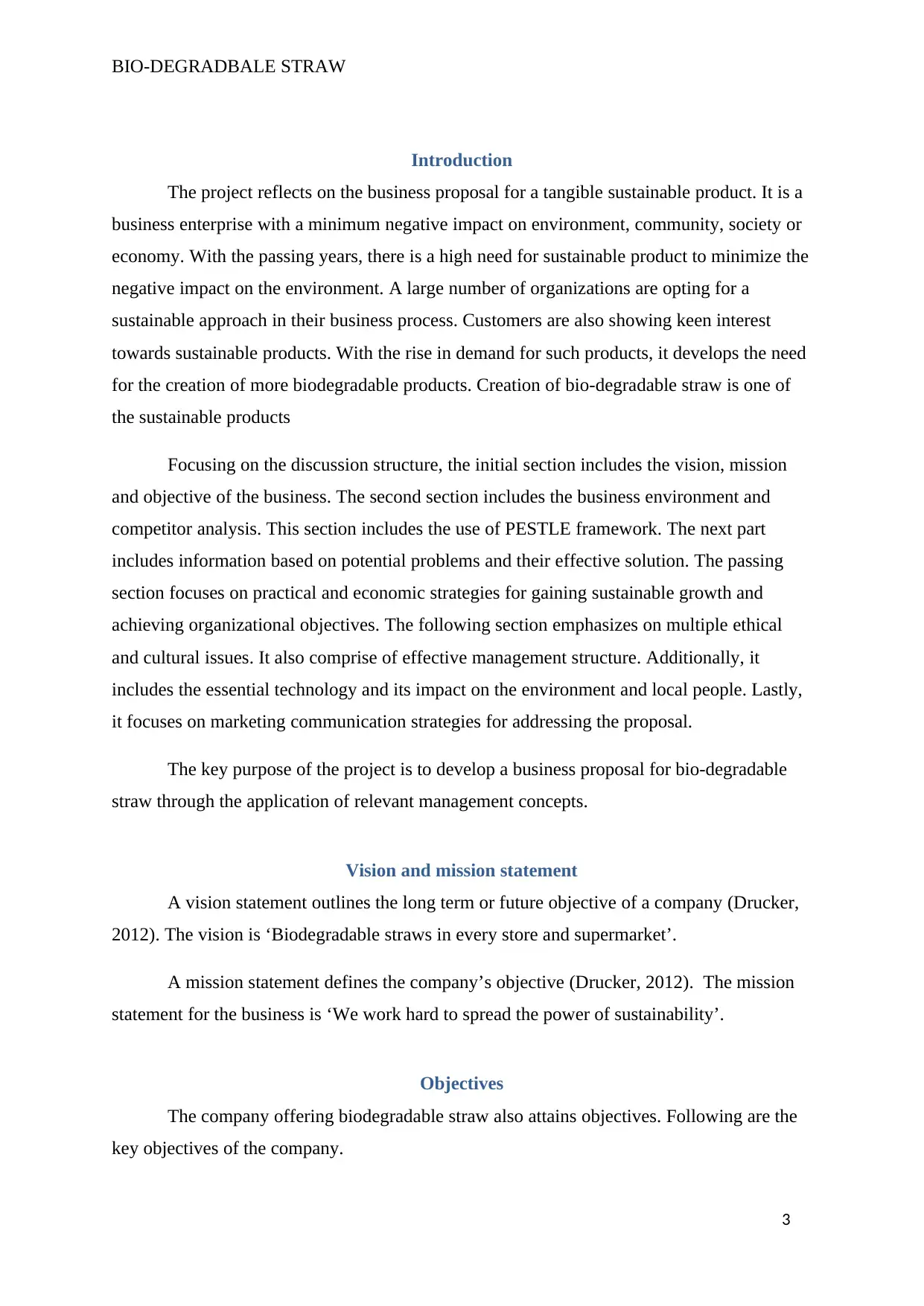
BIO-DEGRADBALE STRAW
Introduction
The project reflects on the business proposal for a tangible sustainable product. It is a
business enterprise with a minimum negative impact on environment, community, society or
economy. With the passing years, there is a high need for sustainable product to minimize the
negative impact on the environment. A large number of organizations are opting for a
sustainable approach in their business process. Customers are also showing keen interest
towards sustainable products. With the rise in demand for such products, it develops the need
for the creation of more biodegradable products. Creation of bio-degradable straw is one of
the sustainable products
Focusing on the discussion structure, the initial section includes the vision, mission
and objective of the business. The second section includes the business environment and
competitor analysis. This section includes the use of PESTLE framework. The next part
includes information based on potential problems and their effective solution. The passing
section focuses on practical and economic strategies for gaining sustainable growth and
achieving organizational objectives. The following section emphasizes on multiple ethical
and cultural issues. It also comprise of effective management structure. Additionally, it
includes the essential technology and its impact on the environment and local people. Lastly,
it focuses on marketing communication strategies for addressing the proposal.
The key purpose of the project is to develop a business proposal for bio-degradable
straw through the application of relevant management concepts.
Vision and mission statement
A vision statement outlines the long term or future objective of a company (Drucker,
2012). The vision is ‘Biodegradable straws in every store and supermarket’.
A mission statement defines the company’s objective (Drucker, 2012). The mission
statement for the business is ‘We work hard to spread the power of sustainability’.
Objectives
The company offering biodegradable straw also attains objectives. Following are the
key objectives of the company.
3
Introduction
The project reflects on the business proposal for a tangible sustainable product. It is a
business enterprise with a minimum negative impact on environment, community, society or
economy. With the passing years, there is a high need for sustainable product to minimize the
negative impact on the environment. A large number of organizations are opting for a
sustainable approach in their business process. Customers are also showing keen interest
towards sustainable products. With the rise in demand for such products, it develops the need
for the creation of more biodegradable products. Creation of bio-degradable straw is one of
the sustainable products
Focusing on the discussion structure, the initial section includes the vision, mission
and objective of the business. The second section includes the business environment and
competitor analysis. This section includes the use of PESTLE framework. The next part
includes information based on potential problems and their effective solution. The passing
section focuses on practical and economic strategies for gaining sustainable growth and
achieving organizational objectives. The following section emphasizes on multiple ethical
and cultural issues. It also comprise of effective management structure. Additionally, it
includes the essential technology and its impact on the environment and local people. Lastly,
it focuses on marketing communication strategies for addressing the proposal.
The key purpose of the project is to develop a business proposal for bio-degradable
straw through the application of relevant management concepts.
Vision and mission statement
A vision statement outlines the long term or future objective of a company (Drucker,
2012). The vision is ‘Biodegradable straws in every store and supermarket’.
A mission statement defines the company’s objective (Drucker, 2012). The mission
statement for the business is ‘We work hard to spread the power of sustainability’.
Objectives
The company offering biodegradable straw also attains objectives. Following are the
key objectives of the company.
3
Paraphrase This Document
Need a fresh take? Get an instant paraphrase of this document with our AI Paraphraser
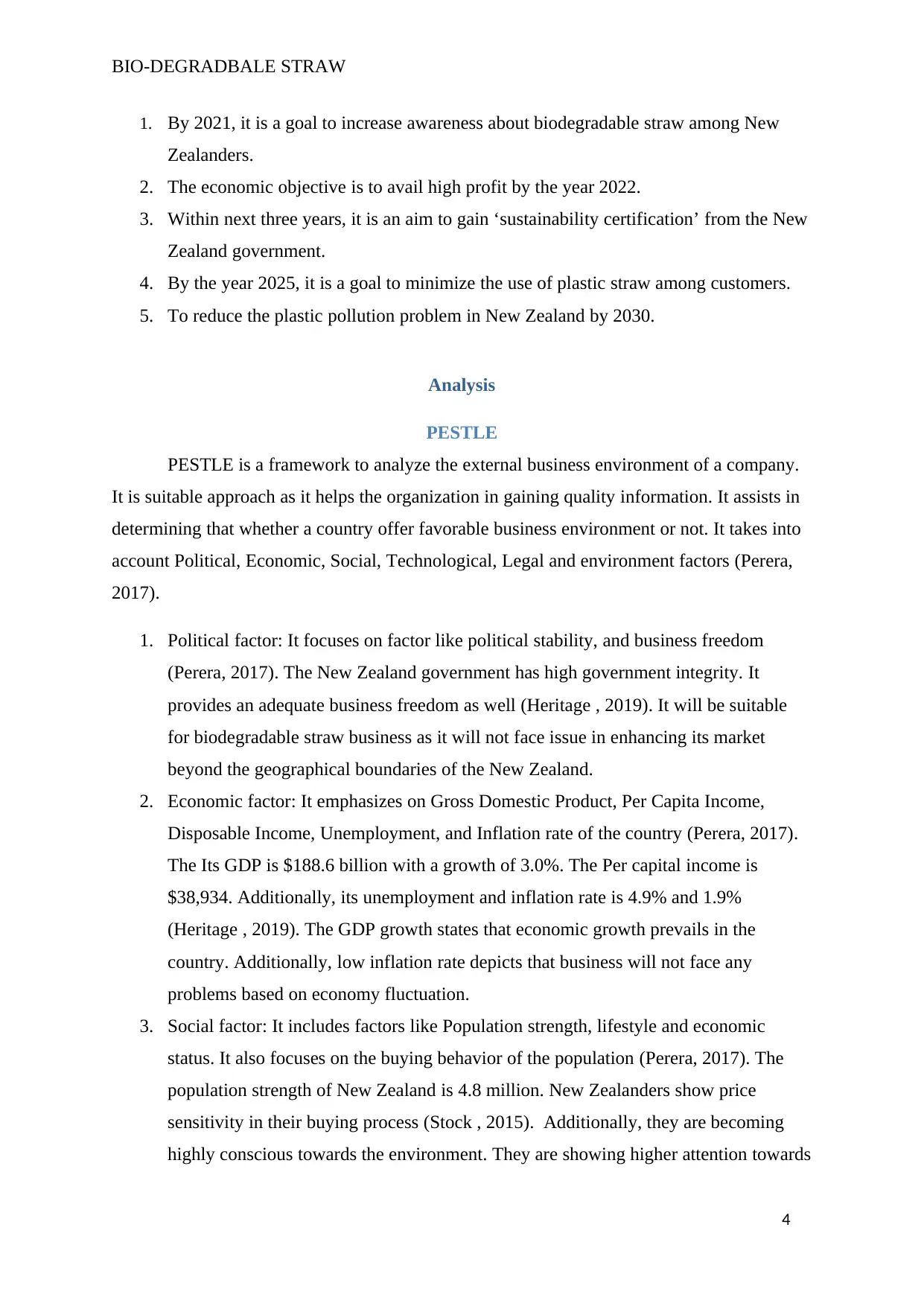
BIO-DEGRADBALE STRAW
1. By 2021, it is a goal to increase awareness about biodegradable straw among New
Zealanders.
2. The economic objective is to avail high profit by the year 2022.
3. Within next three years, it is an aim to gain ‘sustainability certification’ from the New
Zealand government.
4. By the year 2025, it is a goal to minimize the use of plastic straw among customers.
5. To reduce the plastic pollution problem in New Zealand by 2030.
Analysis
PESTLE
PESTLE is a framework to analyze the external business environment of a company.
It is suitable approach as it helps the organization in gaining quality information. It assists in
determining that whether a country offer favorable business environment or not. It takes into
account Political, Economic, Social, Technological, Legal and environment factors (Perera,
2017).
1. Political factor: It focuses on factor like political stability, and business freedom
(Perera, 2017). The New Zealand government has high government integrity. It
provides an adequate business freedom as well (Heritage , 2019). It will be suitable
for biodegradable straw business as it will not face issue in enhancing its market
beyond the geographical boundaries of the New Zealand.
2. Economic factor: It emphasizes on Gross Domestic Product, Per Capita Income,
Disposable Income, Unemployment, and Inflation rate of the country (Perera, 2017).
The Its GDP is $188.6 billion with a growth of 3.0%. The Per capital income is
$38,934. Additionally, its unemployment and inflation rate is 4.9% and 1.9%
(Heritage , 2019). The GDP growth states that economic growth prevails in the
country. Additionally, low inflation rate depicts that business will not face any
problems based on economy fluctuation.
3. Social factor: It includes factors like Population strength, lifestyle and economic
status. It also focuses on the buying behavior of the population (Perera, 2017). The
population strength of New Zealand is 4.8 million. New Zealanders show price
sensitivity in their buying process (Stock , 2015). Additionally, they are becoming
highly conscious towards the environment. They are showing higher attention towards
4
1. By 2021, it is a goal to increase awareness about biodegradable straw among New
Zealanders.
2. The economic objective is to avail high profit by the year 2022.
3. Within next three years, it is an aim to gain ‘sustainability certification’ from the New
Zealand government.
4. By the year 2025, it is a goal to minimize the use of plastic straw among customers.
5. To reduce the plastic pollution problem in New Zealand by 2030.
Analysis
PESTLE
PESTLE is a framework to analyze the external business environment of a company.
It is suitable approach as it helps the organization in gaining quality information. It assists in
determining that whether a country offer favorable business environment or not. It takes into
account Political, Economic, Social, Technological, Legal and environment factors (Perera,
2017).
1. Political factor: It focuses on factor like political stability, and business freedom
(Perera, 2017). The New Zealand government has high government integrity. It
provides an adequate business freedom as well (Heritage , 2019). It will be suitable
for biodegradable straw business as it will not face issue in enhancing its market
beyond the geographical boundaries of the New Zealand.
2. Economic factor: It emphasizes on Gross Domestic Product, Per Capita Income,
Disposable Income, Unemployment, and Inflation rate of the country (Perera, 2017).
The Its GDP is $188.6 billion with a growth of 3.0%. The Per capital income is
$38,934. Additionally, its unemployment and inflation rate is 4.9% and 1.9%
(Heritage , 2019). The GDP growth states that economic growth prevails in the
country. Additionally, low inflation rate depicts that business will not face any
problems based on economy fluctuation.
3. Social factor: It includes factors like Population strength, lifestyle and economic
status. It also focuses on the buying behavior of the population (Perera, 2017). The
population strength of New Zealand is 4.8 million. New Zealanders show price
sensitivity in their buying process (Stock , 2015). Additionally, they are becoming
highly conscious towards the environment. They are showing higher attention towards
4
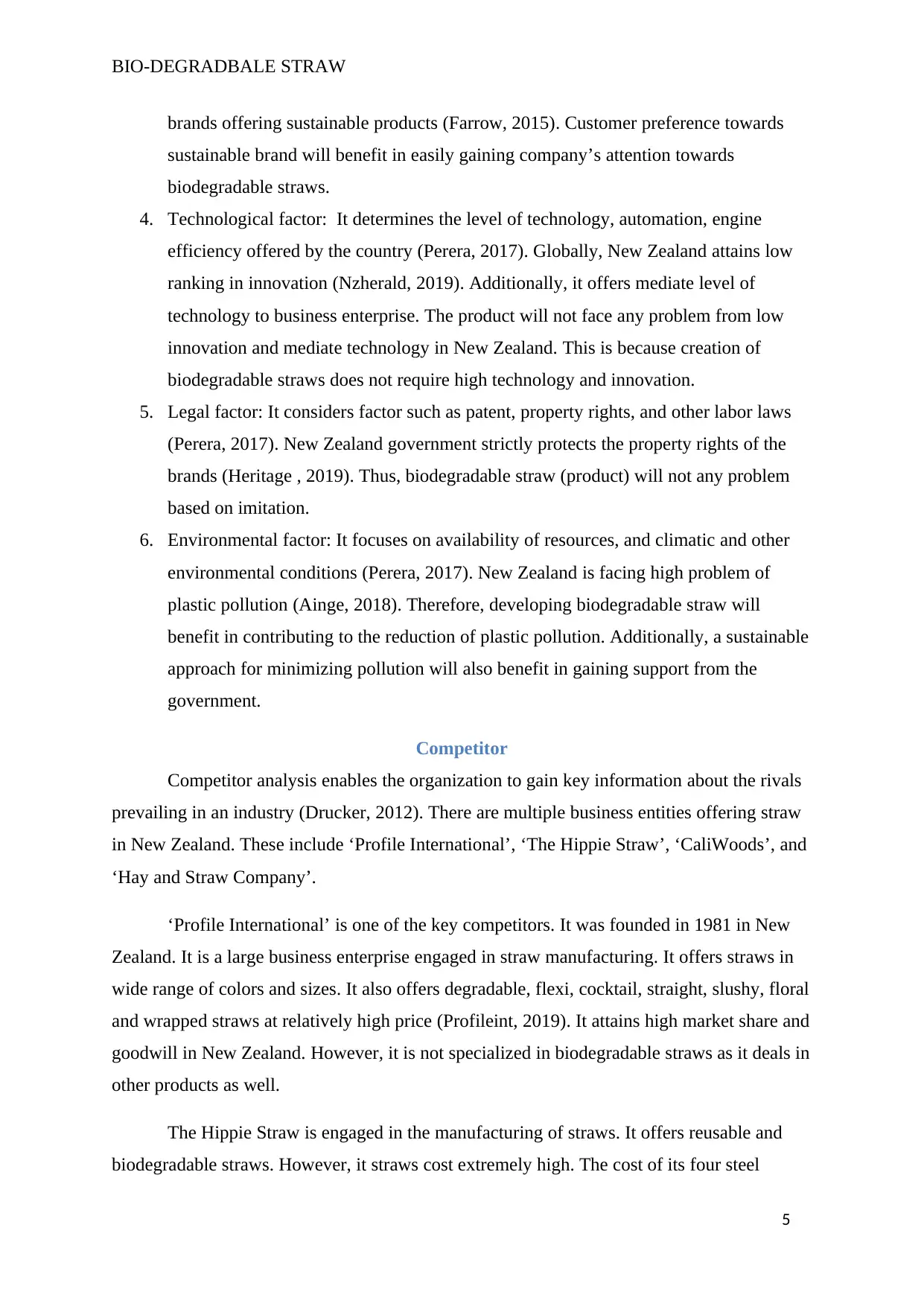
BIO-DEGRADBALE STRAW
brands offering sustainable products (Farrow, 2015). Customer preference towards
sustainable brand will benefit in easily gaining company’s attention towards
biodegradable straws.
4. Technological factor: It determines the level of technology, automation, engine
efficiency offered by the country (Perera, 2017). Globally, New Zealand attains low
ranking in innovation (Nzherald, 2019). Additionally, it offers mediate level of
technology to business enterprise. The product will not face any problem from low
innovation and mediate technology in New Zealand. This is because creation of
biodegradable straws does not require high technology and innovation.
5. Legal factor: It considers factor such as patent, property rights, and other labor laws
(Perera, 2017). New Zealand government strictly protects the property rights of the
brands (Heritage , 2019). Thus, biodegradable straw (product) will not any problem
based on imitation.
6. Environmental factor: It focuses on availability of resources, and climatic and other
environmental conditions (Perera, 2017). New Zealand is facing high problem of
plastic pollution (Ainge, 2018). Therefore, developing biodegradable straw will
benefit in contributing to the reduction of plastic pollution. Additionally, a sustainable
approach for minimizing pollution will also benefit in gaining support from the
government.
Competitor
Competitor analysis enables the organization to gain key information about the rivals
prevailing in an industry (Drucker, 2012). There are multiple business entities offering straw
in New Zealand. These include ‘Profile International’, ‘The Hippie Straw’, ‘CaliWoods’, and
‘Hay and Straw Company’.
‘Profile International’ is one of the key competitors. It was founded in 1981 in New
Zealand. It is a large business enterprise engaged in straw manufacturing. It offers straws in
wide range of colors and sizes. It also offers degradable, flexi, cocktail, straight, slushy, floral
and wrapped straws at relatively high price (Profileint, 2019). It attains high market share and
goodwill in New Zealand. However, it is not specialized in biodegradable straws as it deals in
other products as well.
The Hippie Straw is engaged in the manufacturing of straws. It offers reusable and
biodegradable straws. However, it straws cost extremely high. The cost of its four steel
5
brands offering sustainable products (Farrow, 2015). Customer preference towards
sustainable brand will benefit in easily gaining company’s attention towards
biodegradable straws.
4. Technological factor: It determines the level of technology, automation, engine
efficiency offered by the country (Perera, 2017). Globally, New Zealand attains low
ranking in innovation (Nzherald, 2019). Additionally, it offers mediate level of
technology to business enterprise. The product will not face any problem from low
innovation and mediate technology in New Zealand. This is because creation of
biodegradable straws does not require high technology and innovation.
5. Legal factor: It considers factor such as patent, property rights, and other labor laws
(Perera, 2017). New Zealand government strictly protects the property rights of the
brands (Heritage , 2019). Thus, biodegradable straw (product) will not any problem
based on imitation.
6. Environmental factor: It focuses on availability of resources, and climatic and other
environmental conditions (Perera, 2017). New Zealand is facing high problem of
plastic pollution (Ainge, 2018). Therefore, developing biodegradable straw will
benefit in contributing to the reduction of plastic pollution. Additionally, a sustainable
approach for minimizing pollution will also benefit in gaining support from the
government.
Competitor
Competitor analysis enables the organization to gain key information about the rivals
prevailing in an industry (Drucker, 2012). There are multiple business entities offering straw
in New Zealand. These include ‘Profile International’, ‘The Hippie Straw’, ‘CaliWoods’, and
‘Hay and Straw Company’.
‘Profile International’ is one of the key competitors. It was founded in 1981 in New
Zealand. It is a large business enterprise engaged in straw manufacturing. It offers straws in
wide range of colors and sizes. It also offers degradable, flexi, cocktail, straight, slushy, floral
and wrapped straws at relatively high price (Profileint, 2019). It attains high market share and
goodwill in New Zealand. However, it is not specialized in biodegradable straws as it deals in
other products as well.
The Hippie Straw is engaged in the manufacturing of straws. It offers reusable and
biodegradable straws. However, it straws cost extremely high. The cost of its four steel
5
⊘ This is a preview!⊘
Do you want full access?
Subscribe today to unlock all pages.

Trusted by 1+ million students worldwide
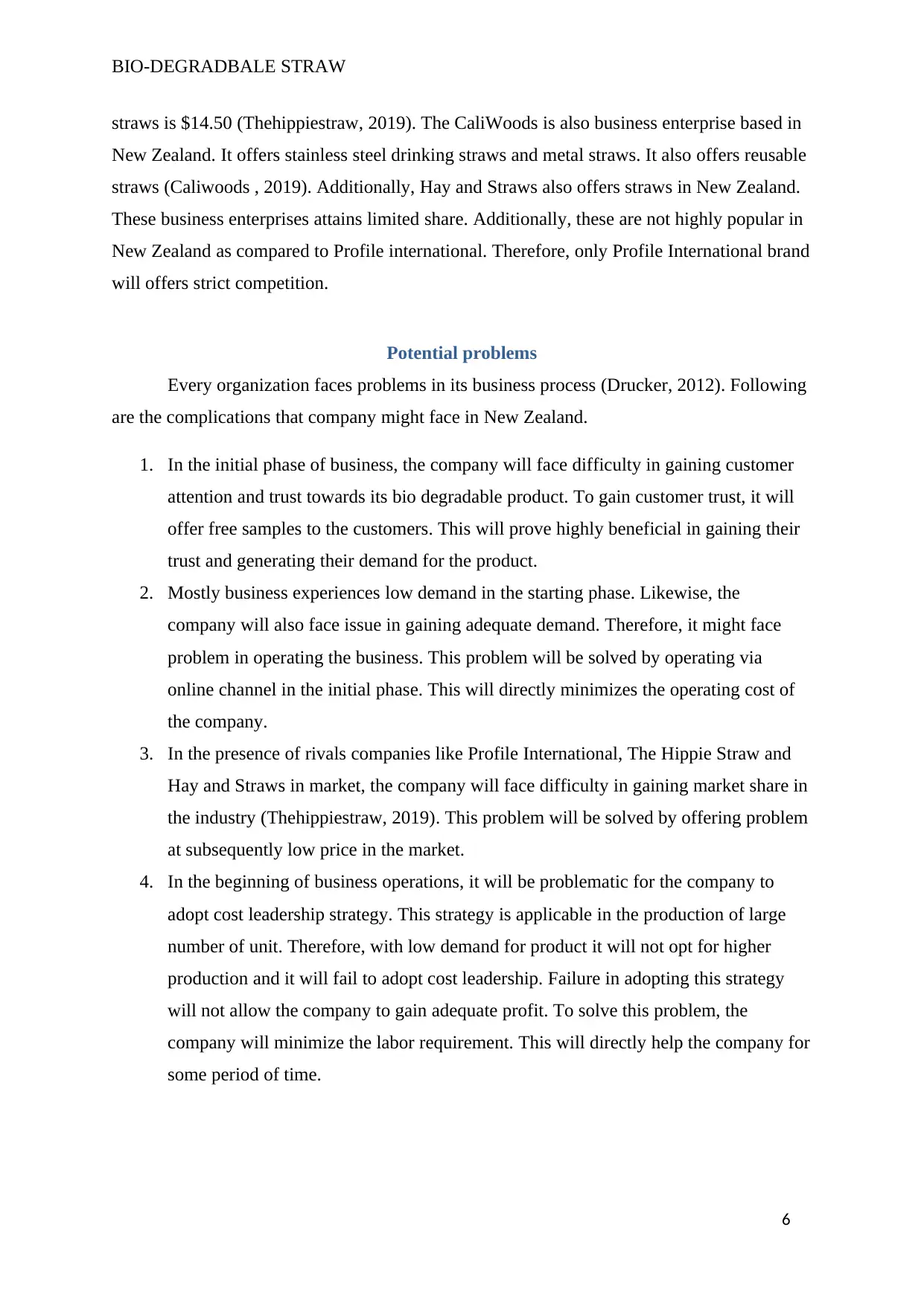
BIO-DEGRADBALE STRAW
straws is $14.50 (Thehippiestraw, 2019). The CaliWoods is also business enterprise based in
New Zealand. It offers stainless steel drinking straws and metal straws. It also offers reusable
straws (Caliwoods , 2019). Additionally, Hay and Straws also offers straws in New Zealand.
These business enterprises attains limited share. Additionally, these are not highly popular in
New Zealand as compared to Profile international. Therefore, only Profile International brand
will offers strict competition.
Potential problems
Every organization faces problems in its business process (Drucker, 2012). Following
are the complications that company might face in New Zealand.
1. In the initial phase of business, the company will face difficulty in gaining customer
attention and trust towards its bio degradable product. To gain customer trust, it will
offer free samples to the customers. This will prove highly beneficial in gaining their
trust and generating their demand for the product.
2. Mostly business experiences low demand in the starting phase. Likewise, the
company will also face issue in gaining adequate demand. Therefore, it might face
problem in operating the business. This problem will be solved by operating via
online channel in the initial phase. This will directly minimizes the operating cost of
the company.
3. In the presence of rivals companies like Profile International, The Hippie Straw and
Hay and Straws in market, the company will face difficulty in gaining market share in
the industry (Thehippiestraw, 2019). This problem will be solved by offering problem
at subsequently low price in the market.
4. In the beginning of business operations, it will be problematic for the company to
adopt cost leadership strategy. This strategy is applicable in the production of large
number of unit. Therefore, with low demand for product it will not opt for higher
production and it will fail to adopt cost leadership. Failure in adopting this strategy
will not allow the company to gain adequate profit. To solve this problem, the
company will minimize the labor requirement. This will directly help the company for
some period of time.
6
straws is $14.50 (Thehippiestraw, 2019). The CaliWoods is also business enterprise based in
New Zealand. It offers stainless steel drinking straws and metal straws. It also offers reusable
straws (Caliwoods , 2019). Additionally, Hay and Straws also offers straws in New Zealand.
These business enterprises attains limited share. Additionally, these are not highly popular in
New Zealand as compared to Profile international. Therefore, only Profile International brand
will offers strict competition.
Potential problems
Every organization faces problems in its business process (Drucker, 2012). Following
are the complications that company might face in New Zealand.
1. In the initial phase of business, the company will face difficulty in gaining customer
attention and trust towards its bio degradable product. To gain customer trust, it will
offer free samples to the customers. This will prove highly beneficial in gaining their
trust and generating their demand for the product.
2. Mostly business experiences low demand in the starting phase. Likewise, the
company will also face issue in gaining adequate demand. Therefore, it might face
problem in operating the business. This problem will be solved by operating via
online channel in the initial phase. This will directly minimizes the operating cost of
the company.
3. In the presence of rivals companies like Profile International, The Hippie Straw and
Hay and Straws in market, the company will face difficulty in gaining market share in
the industry (Thehippiestraw, 2019). This problem will be solved by offering problem
at subsequently low price in the market.
4. In the beginning of business operations, it will be problematic for the company to
adopt cost leadership strategy. This strategy is applicable in the production of large
number of unit. Therefore, with low demand for product it will not opt for higher
production and it will fail to adopt cost leadership. Failure in adopting this strategy
will not allow the company to gain adequate profit. To solve this problem, the
company will minimize the labor requirement. This will directly help the company for
some period of time.
6
Paraphrase This Document
Need a fresh take? Get an instant paraphrase of this document with our AI Paraphraser
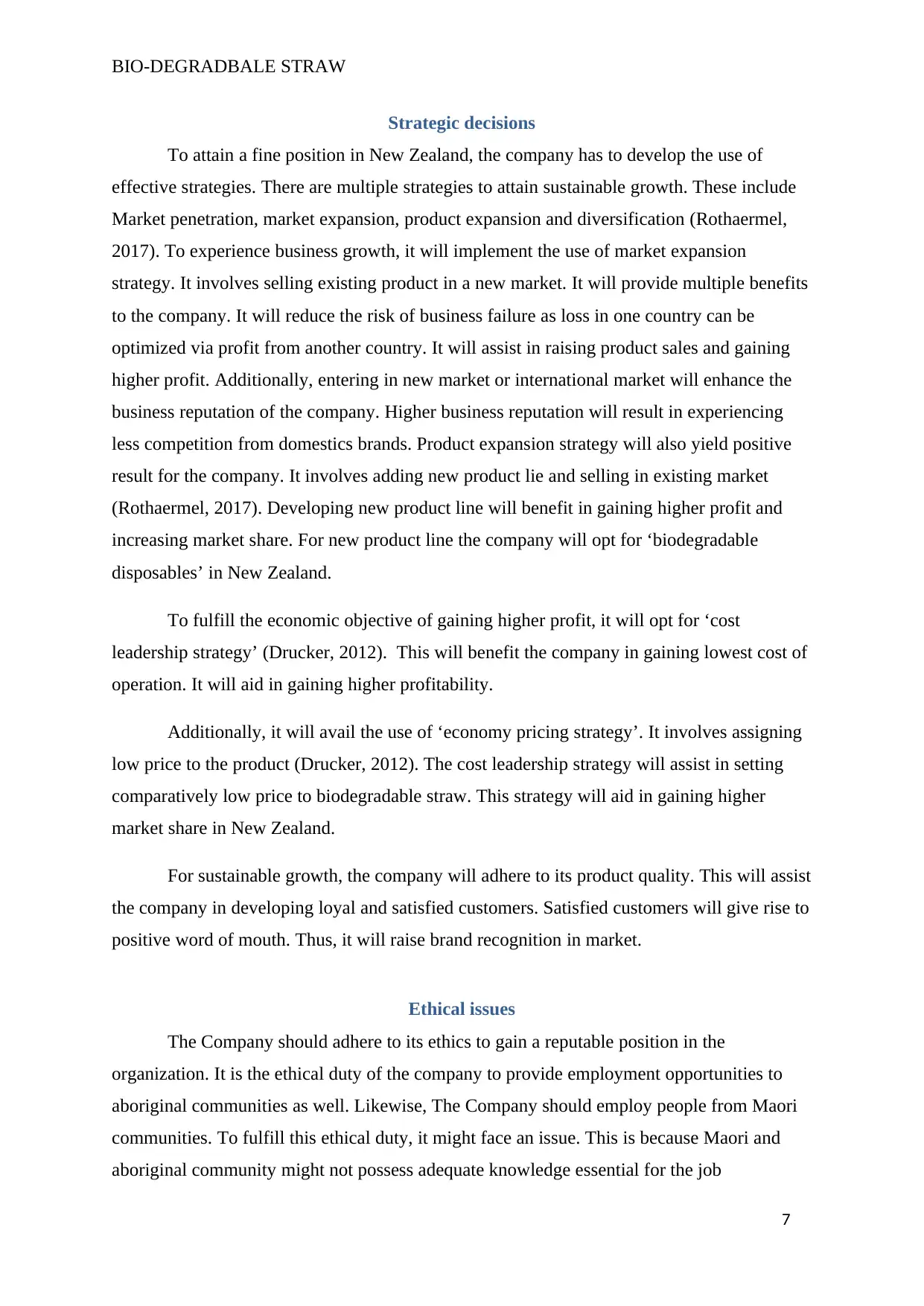
BIO-DEGRADBALE STRAW
Strategic decisions
To attain a fine position in New Zealand, the company has to develop the use of
effective strategies. There are multiple strategies to attain sustainable growth. These include
Market penetration, market expansion, product expansion and diversification (Rothaermel,
2017). To experience business growth, it will implement the use of market expansion
strategy. It involves selling existing product in a new market. It will provide multiple benefits
to the company. It will reduce the risk of business failure as loss in one country can be
optimized via profit from another country. It will assist in raising product sales and gaining
higher profit. Additionally, entering in new market or international market will enhance the
business reputation of the company. Higher business reputation will result in experiencing
less competition from domestics brands. Product expansion strategy will also yield positive
result for the company. It involves adding new product lie and selling in existing market
(Rothaermel, 2017). Developing new product line will benefit in gaining higher profit and
increasing market share. For new product line the company will opt for ‘biodegradable
disposables’ in New Zealand.
To fulfill the economic objective of gaining higher profit, it will opt for ‘cost
leadership strategy’ (Drucker, 2012). This will benefit the company in gaining lowest cost of
operation. It will aid in gaining higher profitability.
Additionally, it will avail the use of ‘economy pricing strategy’. It involves assigning
low price to the product (Drucker, 2012). The cost leadership strategy will assist in setting
comparatively low price to biodegradable straw. This strategy will aid in gaining higher
market share in New Zealand.
For sustainable growth, the company will adhere to its product quality. This will assist
the company in developing loyal and satisfied customers. Satisfied customers will give rise to
positive word of mouth. Thus, it will raise brand recognition in market.
Ethical issues
The Company should adhere to its ethics to gain a reputable position in the
organization. It is the ethical duty of the company to provide employment opportunities to
aboriginal communities as well. Likewise, The Company should employ people from Maori
communities. To fulfill this ethical duty, it might face an issue. This is because Maori and
aboriginal community might not possess adequate knowledge essential for the job
7
Strategic decisions
To attain a fine position in New Zealand, the company has to develop the use of
effective strategies. There are multiple strategies to attain sustainable growth. These include
Market penetration, market expansion, product expansion and diversification (Rothaermel,
2017). To experience business growth, it will implement the use of market expansion
strategy. It involves selling existing product in a new market. It will provide multiple benefits
to the company. It will reduce the risk of business failure as loss in one country can be
optimized via profit from another country. It will assist in raising product sales and gaining
higher profit. Additionally, entering in new market or international market will enhance the
business reputation of the company. Higher business reputation will result in experiencing
less competition from domestics brands. Product expansion strategy will also yield positive
result for the company. It involves adding new product lie and selling in existing market
(Rothaermel, 2017). Developing new product line will benefit in gaining higher profit and
increasing market share. For new product line the company will opt for ‘biodegradable
disposables’ in New Zealand.
To fulfill the economic objective of gaining higher profit, it will opt for ‘cost
leadership strategy’ (Drucker, 2012). This will benefit the company in gaining lowest cost of
operation. It will aid in gaining higher profitability.
Additionally, it will avail the use of ‘economy pricing strategy’. It involves assigning
low price to the product (Drucker, 2012). The cost leadership strategy will assist in setting
comparatively low price to biodegradable straw. This strategy will aid in gaining higher
market share in New Zealand.
For sustainable growth, the company will adhere to its product quality. This will assist
the company in developing loyal and satisfied customers. Satisfied customers will give rise to
positive word of mouth. Thus, it will raise brand recognition in market.
Ethical issues
The Company should adhere to its ethics to gain a reputable position in the
organization. It is the ethical duty of the company to provide employment opportunities to
aboriginal communities as well. Likewise, The Company should employ people from Maori
communities. To fulfill this ethical duty, it might face an issue. This is because Maori and
aboriginal community might not possess adequate knowledge essential for the job
7
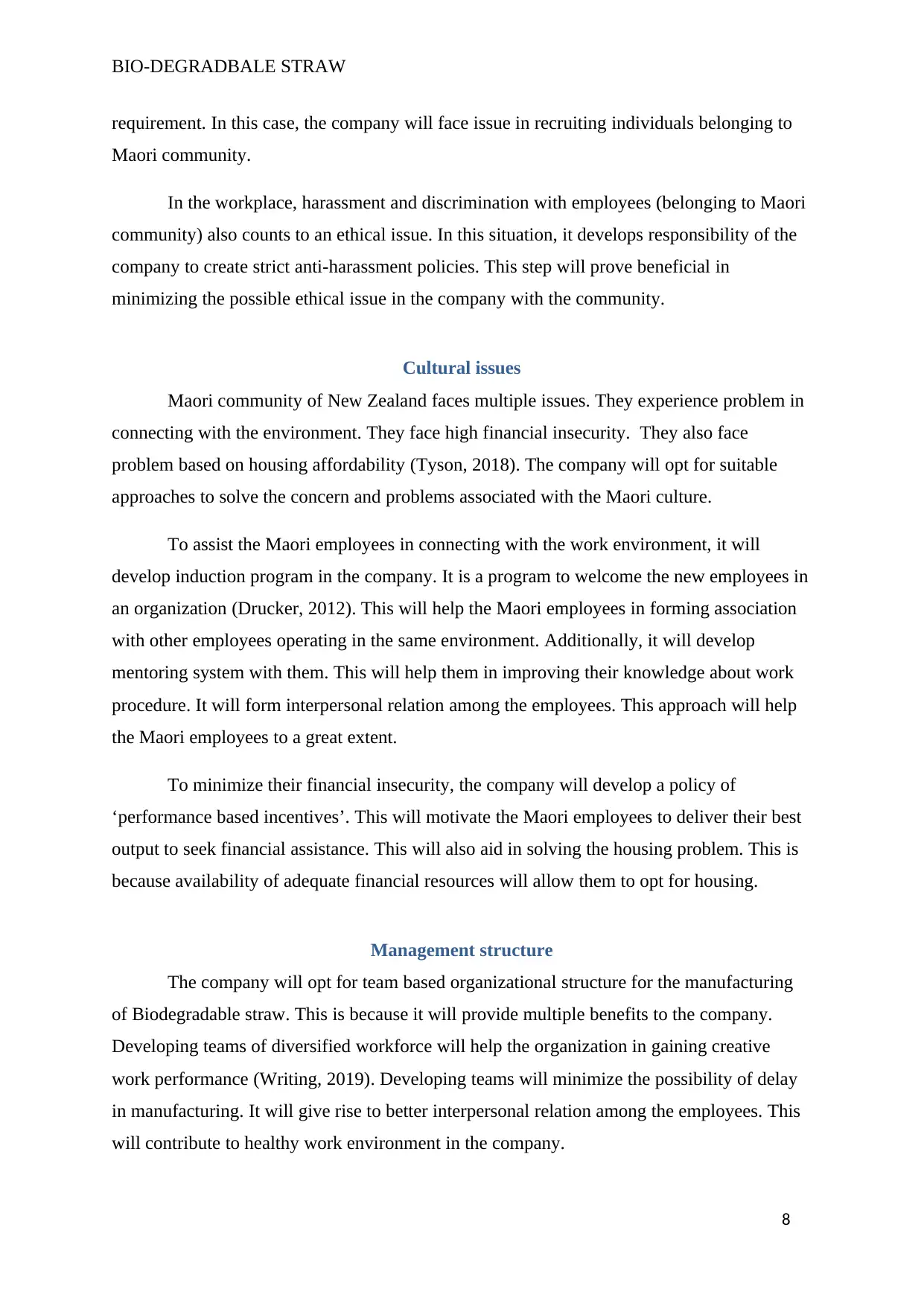
BIO-DEGRADBALE STRAW
requirement. In this case, the company will face issue in recruiting individuals belonging to
Maori community.
In the workplace, harassment and discrimination with employees (belonging to Maori
community) also counts to an ethical issue. In this situation, it develops responsibility of the
company to create strict anti-harassment policies. This step will prove beneficial in
minimizing the possible ethical issue in the company with the community.
Cultural issues
Maori community of New Zealand faces multiple issues. They experience problem in
connecting with the environment. They face high financial insecurity. They also face
problem based on housing affordability (Tyson, 2018). The company will opt for suitable
approaches to solve the concern and problems associated with the Maori culture.
To assist the Maori employees in connecting with the work environment, it will
develop induction program in the company. It is a program to welcome the new employees in
an organization (Drucker, 2012). This will help the Maori employees in forming association
with other employees operating in the same environment. Additionally, it will develop
mentoring system with them. This will help them in improving their knowledge about work
procedure. It will form interpersonal relation among the employees. This approach will help
the Maori employees to a great extent.
To minimize their financial insecurity, the company will develop a policy of
‘performance based incentives’. This will motivate the Maori employees to deliver their best
output to seek financial assistance. This will also aid in solving the housing problem. This is
because availability of adequate financial resources will allow them to opt for housing.
Management structure
The company will opt for team based organizational structure for the manufacturing
of Biodegradable straw. This is because it will provide multiple benefits to the company.
Developing teams of diversified workforce will help the organization in gaining creative
work performance (Writing, 2019). Developing teams will minimize the possibility of delay
in manufacturing. It will give rise to better interpersonal relation among the employees. This
will contribute to healthy work environment in the company.
8
requirement. In this case, the company will face issue in recruiting individuals belonging to
Maori community.
In the workplace, harassment and discrimination with employees (belonging to Maori
community) also counts to an ethical issue. In this situation, it develops responsibility of the
company to create strict anti-harassment policies. This step will prove beneficial in
minimizing the possible ethical issue in the company with the community.
Cultural issues
Maori community of New Zealand faces multiple issues. They experience problem in
connecting with the environment. They face high financial insecurity. They also face
problem based on housing affordability (Tyson, 2018). The company will opt for suitable
approaches to solve the concern and problems associated with the Maori culture.
To assist the Maori employees in connecting with the work environment, it will
develop induction program in the company. It is a program to welcome the new employees in
an organization (Drucker, 2012). This will help the Maori employees in forming association
with other employees operating in the same environment. Additionally, it will develop
mentoring system with them. This will help them in improving their knowledge about work
procedure. It will form interpersonal relation among the employees. This approach will help
the Maori employees to a great extent.
To minimize their financial insecurity, the company will develop a policy of
‘performance based incentives’. This will motivate the Maori employees to deliver their best
output to seek financial assistance. This will also aid in solving the housing problem. This is
because availability of adequate financial resources will allow them to opt for housing.
Management structure
The company will opt for team based organizational structure for the manufacturing
of Biodegradable straw. This is because it will provide multiple benefits to the company.
Developing teams of diversified workforce will help the organization in gaining creative
work performance (Writing, 2019). Developing teams will minimize the possibility of delay
in manufacturing. It will give rise to better interpersonal relation among the employees. This
will contribute to healthy work environment in the company.
8
⊘ This is a preview!⊘
Do you want full access?
Subscribe today to unlock all pages.

Trusted by 1+ million students worldwide
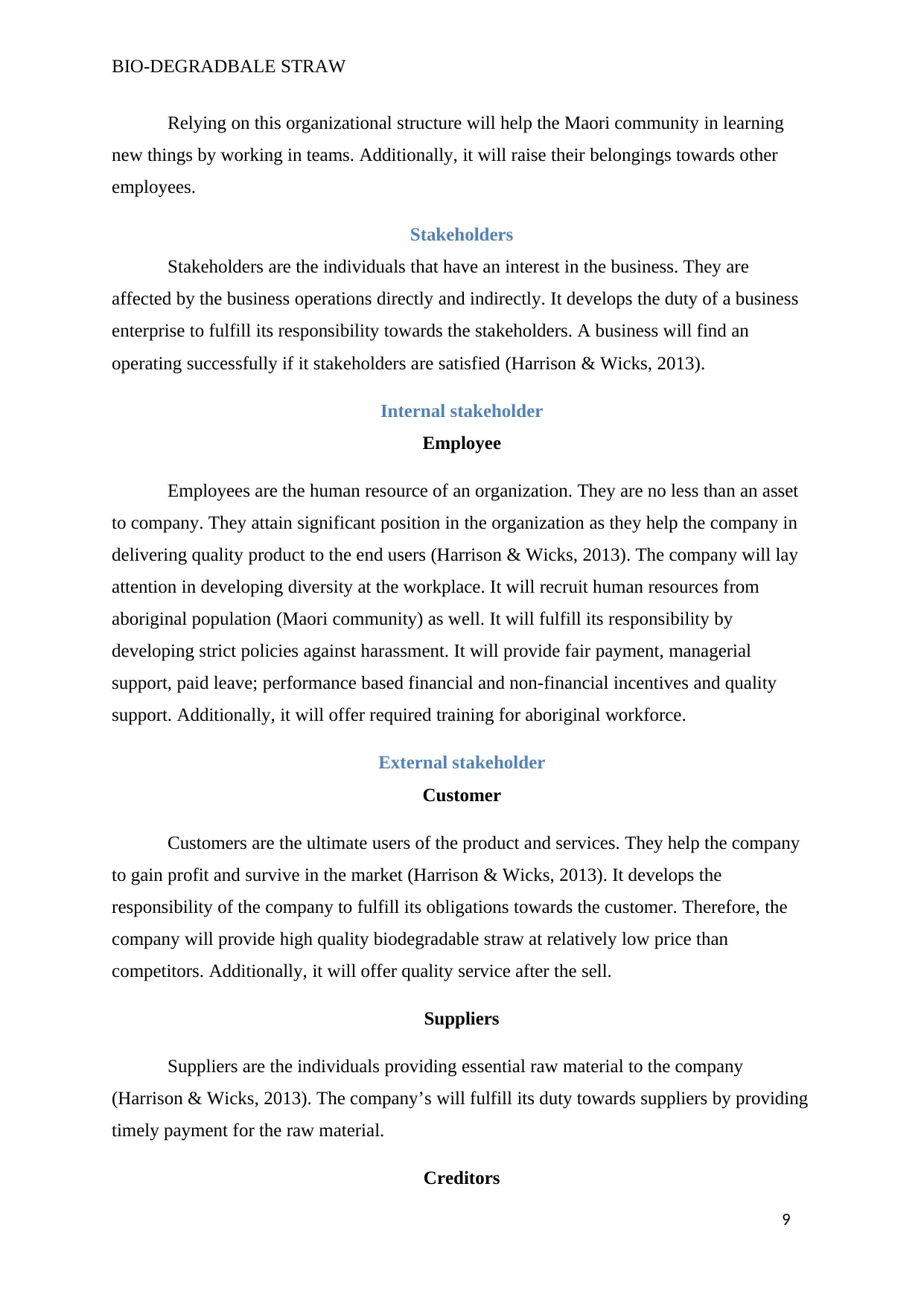
BIO-DEGRADBALE STRAW
Relying on this organizational structure will help the Maori community in learning
new things by working in teams. Additionally, it will raise their belongings towards other
employees.
Stakeholders
Stakeholders are the individuals that have an interest in the business. They are
affected by the business operations directly and indirectly. It develops the duty of a business
enterprise to fulfill its responsibility towards the stakeholders. A business will find an
operating successfully if it stakeholders are satisfied (Harrison & Wicks, 2013).
Internal stakeholder
Employee
Employees are the human resource of an organization. They are no less than an asset
to company. They attain significant position in the organization as they help the company in
delivering quality product to the end users (Harrison & Wicks, 2013). The company will lay
attention in developing diversity at the workplace. It will recruit human resources from
aboriginal population (Maori community) as well. It will fulfill its responsibility by
developing strict policies against harassment. It will provide fair payment, managerial
support, paid leave; performance based financial and non-financial incentives and quality
support. Additionally, it will offer required training for aboriginal workforce.
External stakeholder
Customer
Customers are the ultimate users of the product and services. They help the company
to gain profit and survive in the market (Harrison & Wicks, 2013). It develops the
responsibility of the company to fulfill its obligations towards the customer. Therefore, the
company will provide high quality biodegradable straw at relatively low price than
competitors. Additionally, it will offer quality service after the sell.
Suppliers
Suppliers are the individuals providing essential raw material to the company
(Harrison & Wicks, 2013). The company’s will fulfill its duty towards suppliers by providing
timely payment for the raw material.
Creditors
9
Relying on this organizational structure will help the Maori community in learning
new things by working in teams. Additionally, it will raise their belongings towards other
employees.
Stakeholders
Stakeholders are the individuals that have an interest in the business. They are
affected by the business operations directly and indirectly. It develops the duty of a business
enterprise to fulfill its responsibility towards the stakeholders. A business will find an
operating successfully if it stakeholders are satisfied (Harrison & Wicks, 2013).
Internal stakeholder
Employee
Employees are the human resource of an organization. They are no less than an asset
to company. They attain significant position in the organization as they help the company in
delivering quality product to the end users (Harrison & Wicks, 2013). The company will lay
attention in developing diversity at the workplace. It will recruit human resources from
aboriginal population (Maori community) as well. It will fulfill its responsibility by
developing strict policies against harassment. It will provide fair payment, managerial
support, paid leave; performance based financial and non-financial incentives and quality
support. Additionally, it will offer required training for aboriginal workforce.
External stakeholder
Customer
Customers are the ultimate users of the product and services. They help the company
to gain profit and survive in the market (Harrison & Wicks, 2013). It develops the
responsibility of the company to fulfill its obligations towards the customer. Therefore, the
company will provide high quality biodegradable straw at relatively low price than
competitors. Additionally, it will offer quality service after the sell.
Suppliers
Suppliers are the individuals providing essential raw material to the company
(Harrison & Wicks, 2013). The company’s will fulfill its duty towards suppliers by providing
timely payment for the raw material.
Creditors
9
Paraphrase This Document
Need a fresh take? Get an instant paraphrase of this document with our AI Paraphraser
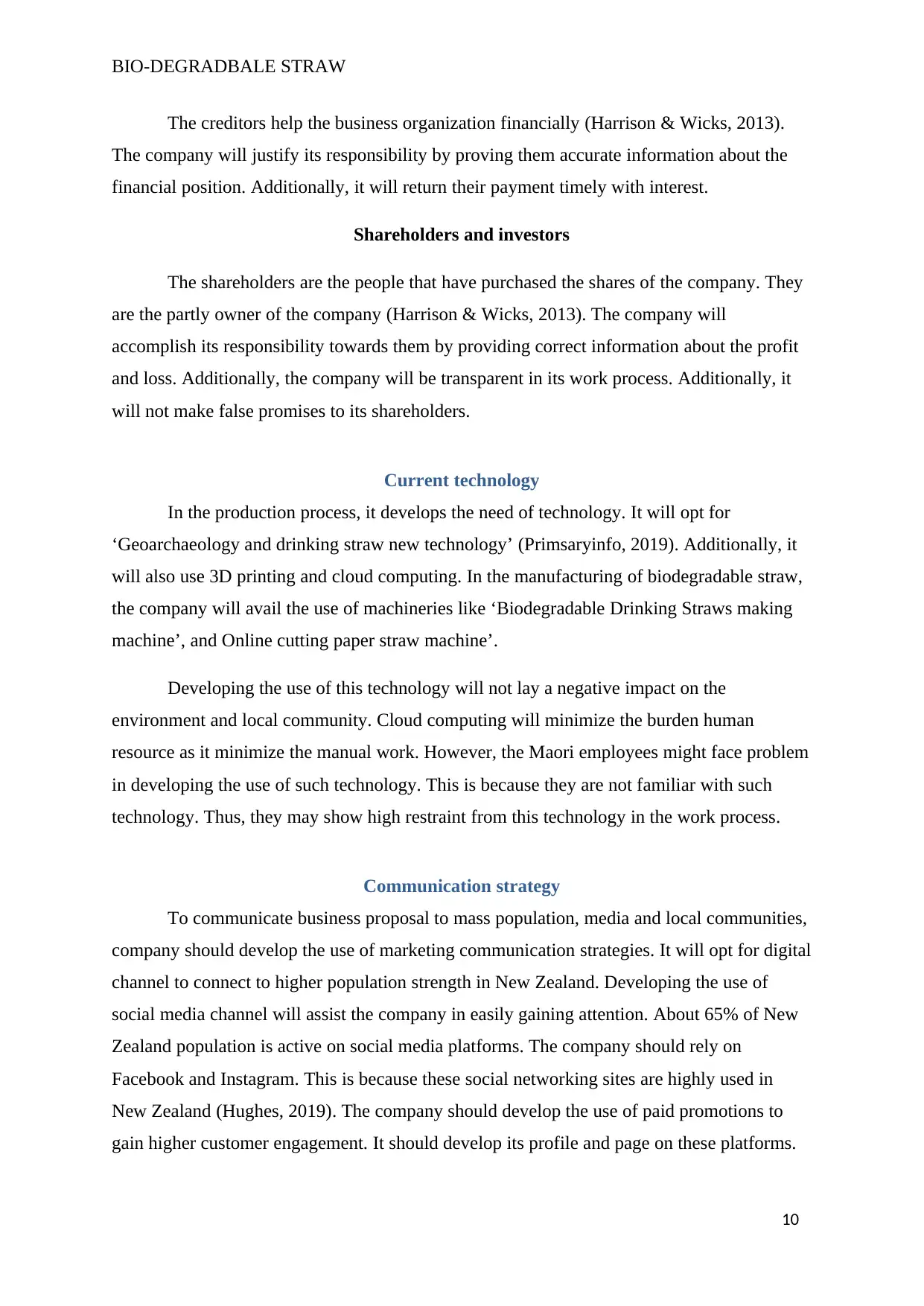
BIO-DEGRADBALE STRAW
The creditors help the business organization financially (Harrison & Wicks, 2013).
The company will justify its responsibility by proving them accurate information about the
financial position. Additionally, it will return their payment timely with interest.
Shareholders and investors
The shareholders are the people that have purchased the shares of the company. They
are the partly owner of the company (Harrison & Wicks, 2013). The company will
accomplish its responsibility towards them by providing correct information about the profit
and loss. Additionally, the company will be transparent in its work process. Additionally, it
will not make false promises to its shareholders.
Current technology
In the production process, it develops the need of technology. It will opt for
‘Geoarchaeology and drinking straw new technology’ (Primsaryinfo, 2019). Additionally, it
will also use 3D printing and cloud computing. In the manufacturing of biodegradable straw,
the company will avail the use of machineries like ‘Biodegradable Drinking Straws making
machine’, and Online cutting paper straw machine’.
Developing the use of this technology will not lay a negative impact on the
environment and local community. Cloud computing will minimize the burden human
resource as it minimize the manual work. However, the Maori employees might face problem
in developing the use of such technology. This is because they are not familiar with such
technology. Thus, they may show high restraint from this technology in the work process.
Communication strategy
To communicate business proposal to mass population, media and local communities,
company should develop the use of marketing communication strategies. It will opt for digital
channel to connect to higher population strength in New Zealand. Developing the use of
social media channel will assist the company in easily gaining attention. About 65% of New
Zealand population is active on social media platforms. The company should rely on
Facebook and Instagram. This is because these social networking sites are highly used in
New Zealand (Hughes, 2019). The company should develop the use of paid promotions to
gain higher customer engagement. It should develop its profile and page on these platforms.
10
The creditors help the business organization financially (Harrison & Wicks, 2013).
The company will justify its responsibility by proving them accurate information about the
financial position. Additionally, it will return their payment timely with interest.
Shareholders and investors
The shareholders are the people that have purchased the shares of the company. They
are the partly owner of the company (Harrison & Wicks, 2013). The company will
accomplish its responsibility towards them by providing correct information about the profit
and loss. Additionally, the company will be transparent in its work process. Additionally, it
will not make false promises to its shareholders.
Current technology
In the production process, it develops the need of technology. It will opt for
‘Geoarchaeology and drinking straw new technology’ (Primsaryinfo, 2019). Additionally, it
will also use 3D printing and cloud computing. In the manufacturing of biodegradable straw,
the company will avail the use of machineries like ‘Biodegradable Drinking Straws making
machine’, and Online cutting paper straw machine’.
Developing the use of this technology will not lay a negative impact on the
environment and local community. Cloud computing will minimize the burden human
resource as it minimize the manual work. However, the Maori employees might face problem
in developing the use of such technology. This is because they are not familiar with such
technology. Thus, they may show high restraint from this technology in the work process.
Communication strategy
To communicate business proposal to mass population, media and local communities,
company should develop the use of marketing communication strategies. It will opt for digital
channel to connect to higher population strength in New Zealand. Developing the use of
social media channel will assist the company in easily gaining attention. About 65% of New
Zealand population is active on social media platforms. The company should rely on
Facebook and Instagram. This is because these social networking sites are highly used in
New Zealand (Hughes, 2019). The company should develop the use of paid promotions to
gain higher customer engagement. It should develop its profile and page on these platforms.
10
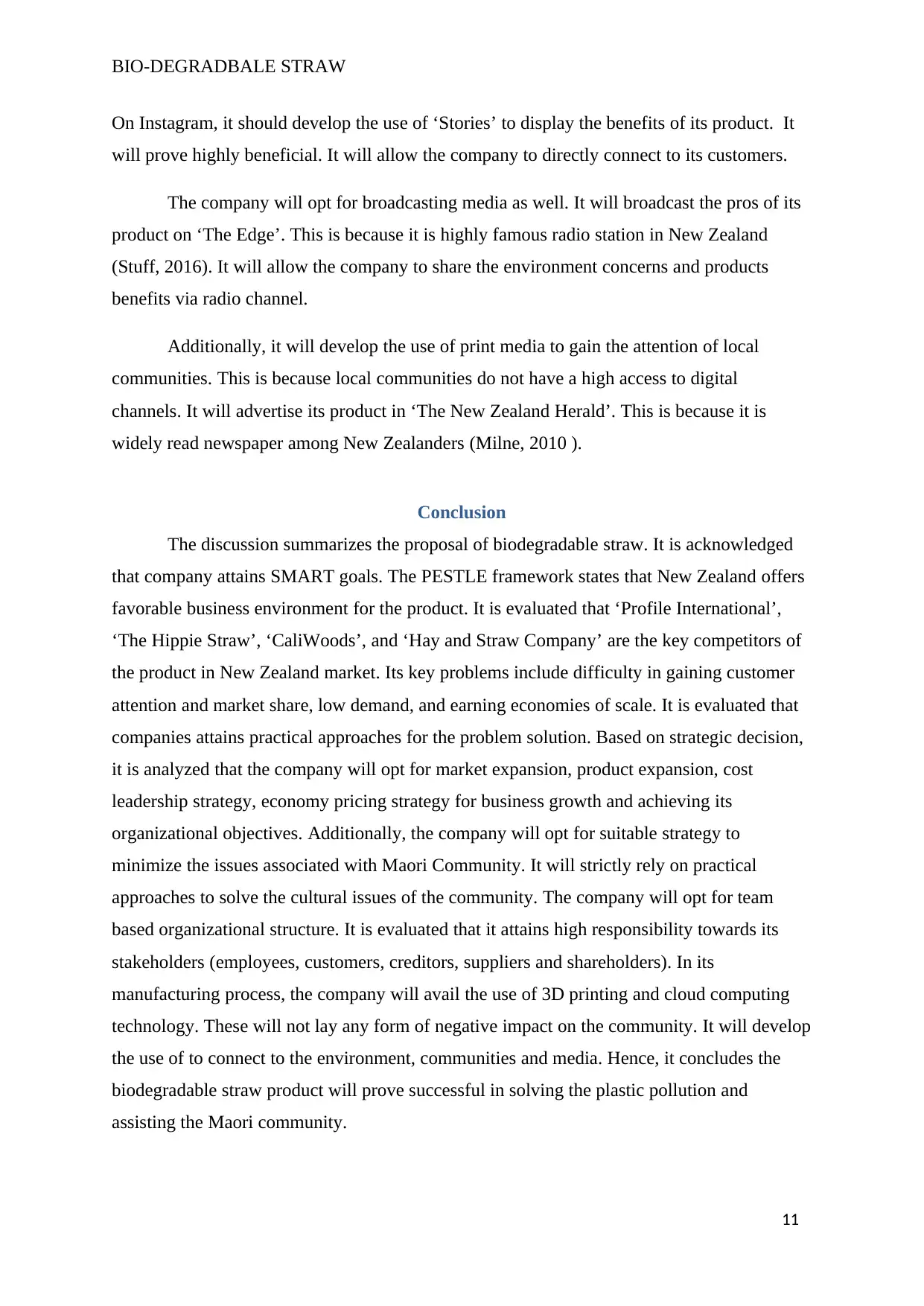
BIO-DEGRADBALE STRAW
On Instagram, it should develop the use of ‘Stories’ to display the benefits of its product. It
will prove highly beneficial. It will allow the company to directly connect to its customers.
The company will opt for broadcasting media as well. It will broadcast the pros of its
product on ‘The Edge’. This is because it is highly famous radio station in New Zealand
(Stuff, 2016). It will allow the company to share the environment concerns and products
benefits via radio channel.
Additionally, it will develop the use of print media to gain the attention of local
communities. This is because local communities do not have a high access to digital
channels. It will advertise its product in ‘The New Zealand Herald’. This is because it is
widely read newspaper among New Zealanders (Milne, 2010 ).
Conclusion
The discussion summarizes the proposal of biodegradable straw. It is acknowledged
that company attains SMART goals. The PESTLE framework states that New Zealand offers
favorable business environment for the product. It is evaluated that ‘Profile International’,
‘The Hippie Straw’, ‘CaliWoods’, and ‘Hay and Straw Company’ are the key competitors of
the product in New Zealand market. Its key problems include difficulty in gaining customer
attention and market share, low demand, and earning economies of scale. It is evaluated that
companies attains practical approaches for the problem solution. Based on strategic decision,
it is analyzed that the company will opt for market expansion, product expansion, cost
leadership strategy, economy pricing strategy for business growth and achieving its
organizational objectives. Additionally, the company will opt for suitable strategy to
minimize the issues associated with Maori Community. It will strictly rely on practical
approaches to solve the cultural issues of the community. The company will opt for team
based organizational structure. It is evaluated that it attains high responsibility towards its
stakeholders (employees, customers, creditors, suppliers and shareholders). In its
manufacturing process, the company will avail the use of 3D printing and cloud computing
technology. These will not lay any form of negative impact on the community. It will develop
the use of to connect to the environment, communities and media. Hence, it concludes the
biodegradable straw product will prove successful in solving the plastic pollution and
assisting the Maori community.
11
On Instagram, it should develop the use of ‘Stories’ to display the benefits of its product. It
will prove highly beneficial. It will allow the company to directly connect to its customers.
The company will opt for broadcasting media as well. It will broadcast the pros of its
product on ‘The Edge’. This is because it is highly famous radio station in New Zealand
(Stuff, 2016). It will allow the company to share the environment concerns and products
benefits via radio channel.
Additionally, it will develop the use of print media to gain the attention of local
communities. This is because local communities do not have a high access to digital
channels. It will advertise its product in ‘The New Zealand Herald’. This is because it is
widely read newspaper among New Zealanders (Milne, 2010 ).
Conclusion
The discussion summarizes the proposal of biodegradable straw. It is acknowledged
that company attains SMART goals. The PESTLE framework states that New Zealand offers
favorable business environment for the product. It is evaluated that ‘Profile International’,
‘The Hippie Straw’, ‘CaliWoods’, and ‘Hay and Straw Company’ are the key competitors of
the product in New Zealand market. Its key problems include difficulty in gaining customer
attention and market share, low demand, and earning economies of scale. It is evaluated that
companies attains practical approaches for the problem solution. Based on strategic decision,
it is analyzed that the company will opt for market expansion, product expansion, cost
leadership strategy, economy pricing strategy for business growth and achieving its
organizational objectives. Additionally, the company will opt for suitable strategy to
minimize the issues associated with Maori Community. It will strictly rely on practical
approaches to solve the cultural issues of the community. The company will opt for team
based organizational structure. It is evaluated that it attains high responsibility towards its
stakeholders (employees, customers, creditors, suppliers and shareholders). In its
manufacturing process, the company will avail the use of 3D printing and cloud computing
technology. These will not lay any form of negative impact on the community. It will develop
the use of to connect to the environment, communities and media. Hence, it concludes the
biodegradable straw product will prove successful in solving the plastic pollution and
assisting the Maori community.
11
⊘ This is a preview!⊘
Do you want full access?
Subscribe today to unlock all pages.

Trusted by 1+ million students worldwide
1 out of 14
Related Documents
Your All-in-One AI-Powered Toolkit for Academic Success.
+13062052269
info@desklib.com
Available 24*7 on WhatsApp / Email
![[object Object]](/_next/static/media/star-bottom.7253800d.svg)
Unlock your academic potential
Copyright © 2020–2025 A2Z Services. All Rights Reserved. Developed and managed by ZUCOL.





